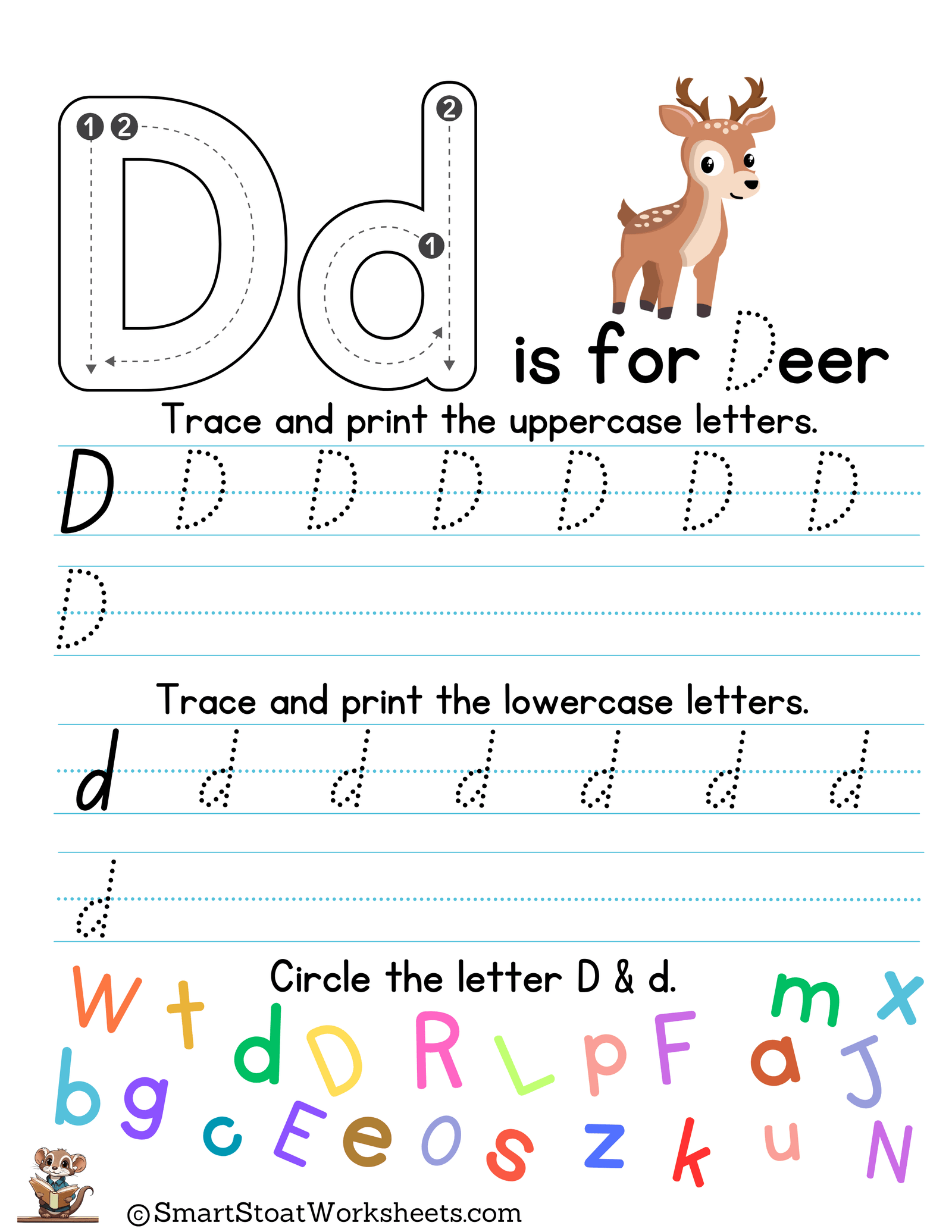How to Use Our “Letter D Writing and Printing Practice Sheets” for Preschool and Kindergarten
Teaching young children how to write the letter D is a key step in their early literacy development. Our “letter D writing and printing practice sheets” are designed to make this learning process enjoyable and effective. Below, you’ll find a step-by-step guide with tips and advice on how to use these worksheets to teach preschool and kindergarten children.
1. Introduce the Letter D
- Begin with Recognition: Start by introducing the letter D to your child or students. Show them both the uppercase (D) and lowercase (d) versions of the letter. Use flashcards, alphabet books, or classroom posters to reinforce letter recognition.
- Sound it Out: Help children connect the letter with its sound by saying, “D is for Deer” or using other simple words that begin with D. Associating the letter with familiar words helps with retention.
2. Demonstrate the Proper Writing Technique
- Model the Writing Process: Before using the worksheet, demonstrate how to write the letter D. Use a whiteboard or large sheet of paper to show the correct strokes for both uppercase and lowercase D. Emphasize starting points, the direction of strokes, and proper pencil grip.
- Use Verbal Cues: As you write, describe the steps aloud (e.g., “Start at the top, draw a straight line down, and then make a big curve from top to bottom for uppercase D”).
3. Engage with the Worksheet
- Guided Practice: Sit with your child or students as they begin the worksheet. Start with the first few lines together, offering support and gentle corrections if needed. Ensure they’re following the stroke order for both uppercase and lowercase D.
- Use the Tracing Lines: The worksheet typically begins with tracing the letter. Encourage children to carefully trace over the dotted lines to get used to the motion before attempting freehand writing.
4. Encourage Independent Practice
- Move to Freehand Writing: Once the tracing section is complete, encourage children to write the letter D on their own. Remind them of the steps and allow them to practice multiple times.
- Provide Positive Feedback: Offer praise for their efforts and gently correct any mistakes. Focus on their progress and improvement rather than perfection.
5. Reinforce Learning with Activities
- Letter D Hunt: Make learning interactive by having children search for the letter in books, magazines, or around the classroom. This activity reinforces their recognition and understanding of the letter.
- Creative Crafts: Incorporate arts and crafts, such as cutting it out from construction paper or decorating it with drawings of things that start with D (like deer). This hands-on activity helps solidify the letter in their memory.
6. Review and Reflect
- Daily Practice: Consistent practice is essential for mastering handwriting. Incorporate the worksheet into your daily or weekly routines, gradually increasing the complexity as your child or students become more confident.
- Review Progress: At the end of each session, review the completed work together. Discuss what they did well and areas for improvement. Celebrate their progress to keep them motivated and excited about learning.
7. Extend the Learning
- Introduce Related Words: Once they’re comfortable with the letter D, introduce simple words that start with D (e.g., dog, duck, and door). Practice writing these words together, using the worksheet as a base for forming the letter D.
- Integrate with Other Learning Areas: Connect letter writing with other subjects. For example, draw a picture of a dog and practice writing the word alongside it, integrating art and literacy in a fun way.
Final Thoughts
Using our “letter D writing and printing practice sheets” can be a fun and rewarding experience for both you and your child or students. With these tips, you’ll be able to guide them through the process of learning to write, setting a strong foundation for their future handwriting skills. Remember to be patient, offer plenty of encouragement, and make the learning process as enjoyable as possible!
About Smart Stoats
At Smart Stoats, we’re passionate about supporting the early education of young learners. We offer a wide range of free resources for teachers and parents of preschool and kindergarten children, designed to make learning fun and engaging. Our mission is to provide high-quality, accessible educational materials that help children develop strong foundational skills. Explore our collection of worksheets, activities, and teaching guides to find the perfect resources for your classroom or home.
